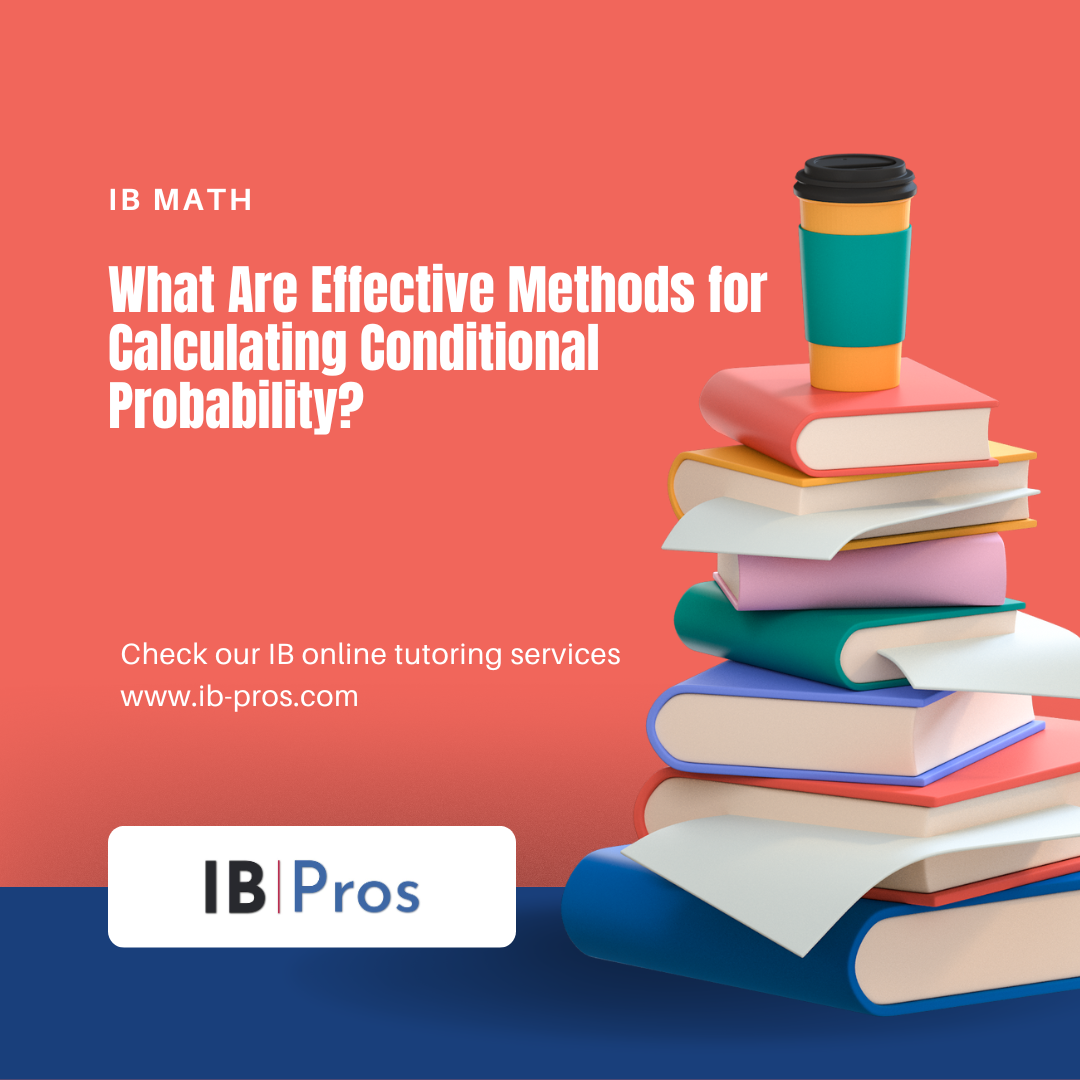
Conditional probability, the measure of the likelihood of an event occurring given that another event has already taken place, stands as a fundamental concept in probability theory and has widespread applications across various disciplines. From the realms of statistics to decision-making processes in business and advancements in artificial intelligence, the capacity to accurately determine such probabilities is indispensable. While the basic formula, P(A|B) = P(A ∩ B) / P(B), provides a straightforward computational path, the application of this formula can present complexities depending on the context and available data. Alternative methods, such as the use of Venn diagrams for visualizing probabilities or contingency tables for organizing and analyzing categorical data, offer additional tools for grappling with these challenges. Moreover, the Bayesian approach to probability updates introduces a dynamic aspect to conditional probability calculations, accounting for new information as it becomes available. The selection of an effective method for calculating conditional probabilities requires a nuanced understanding of these techniques and their appropriate contexts, a topic which, when explored, reveals the intricate dance between theory and practice in the quest for precision and understanding in probabilistic assessments.
Key Takeaways
- Conditional probability quantifies the likelihood of an event occurring given that another event has already taken place.
- The formula P(A|B) = P(A ∩ B) / P(B) is used to calculate conditional probability.
- The Venn Diagram Technique offers a visual representation for calculating conditional probabilities.
- The Contingency Table Method is used for calculating conditional probabilities with categorical data.
Understanding the Basics
Conditional probability is a fundamental concept in statistics that quantifies the likelihood of an event occurring, given that another event has already taken place. This premise is crucial for understanding the interdependence of events within a given probability space. By definition, the conditional probability of an event A, given that event B has occurred, is denoted by P(A|B) and is calculated using the formula P(A|B) = P(A ∩ B) / P(B), provided that P(B) > 0. This expression requires the joint probability of A and B occurring simultaneously, represented by P(A ∩ B), and the probability of the event B.
In practice, the computation of conditional probabilities necessitates a systematic approach, ensuring that the events are appropriately defined within the sample space. Analysts must ensure that the probabilities are derived from a consistent probability distribution and that the events in question are relevant to the conditional context. The precision of this calculation is paramount, as it often serves as the foundation for more complex probabilistic inferences, such as Bayes’ theorem, which further refines the understanding of the likelihood of events based on new information.
The Formula Approach
Having established the conceptual groundwork of conditional probability, we now focus on the precise methodology for its calculation, known as the formula approach. This method employs a straightforward equation: P(A|B) = P(A ∩ B) / P(B), where P(A|B) represents the probability of event A occurring given that event B has occurred, P(A ∩ B) denotes the joint probability of events A and B occurring simultaneously, and P(B) is the probability of event B.
The formula approach necessitates a rigorous evaluation of probabilities, emphasizing an analytical perspective. It requires the assessment of the joint probability, which involves calculating the likelihood that both events will occur together. This calculation can be complex, depending on the interdependence of the events in question. Additionally, the marginal probability of the conditioning event, P(B), must be non-zero to avoid division by zero, which would invalidate the calculation.
For empirical applications, the formula approach is often operationalized through frequency data or experimentally derived probabilities. In statistical practice, this translates to the use of observed frequencies or proportions to estimate the probabilities involved in the formula. The method’s utility is contingent upon the accurate determination of these probabilities, underscoring the importance of meticulous data collection and analysis.
Venn Diagram Technique
The Venn Diagram Technique offers a visual representation to aid in the comprehension and calculation of conditional probabilities, illuminating the relationship between sets and their intersections. By drawing circles that represent different events or conditions, the Venn Diagram methodically delineates the various possible combinations of occurrences within a universal set. This technique is particularly efficacious when dealing with two or three variables, though it becomes less practical as the number of variables increases due to the complexity of the diagram.
In the context of conditional probability, the Venn Diagram is instrumental in identifying the pertinent subset of events. The probability of event A given event B, denoted as P(A|B), can be visually quantified by the ratio of the intersection of sets A and B to the set B exclusively. Analytically, the area common to both circles A and B represents the intersection, while the entire area of circle B corresponds to the condition upon which event A is contingent.
Thus, the Venn Diagram serves as a technical tool that enhances clarity and accuracy in the computation process. It eliminates ambiguity by providing a concrete illustration of how different probabilities coalesce, fostering a deeper understanding of the fundamental principles underlying conditional probability.
Contingency Table Method
Transitioning from the Venn Diagram, the Contingency Table Method presents a structured approach for calculating conditional probabilities, particularly beneficial when dealing with categorical data. This tabular representation is instrumental for cross-classifying data according to two variables or attributes, which are typically defined as rows and columns. The intersection of these rows and columns denotes the frequency or count of occurrences for each category combination.
The analytical potency of the Contingency Table lies in its ability to delineate joint distributions of the variables at hand succinctly. By summing the relevant frequencies, one can obtain marginal distributions, which are crucial for determining the unconditional probabilities of events. The calculation of conditional probabilities then follows the axiom P(A|B) = P(A ∩ B) / P(B), where P(A ∩ B) is the probability of the intersection of events A and B, and P(B) is the probability of event B.
In practice, the methodical extraction of these probabilities involves dividing the joint frequency of A and B by the marginal frequency of B. This procedure yields an empirical conditional probability that is pivotal for inferential statistics. The technical precision of contingency tables ensures their widespread use in fields requiring meticulous data analysis, such as epidemiology, market research, and social sciences.
Bayesian Probability Update
Building upon foundational probability concepts, Bayesian Probability Update is a statistical technique that refines initial beliefs in light of new evidence. This method is grounded in Bayes’ theorem, which mathematically expresses how a subjective degree of belief should rationally change to account for availability of related data. Bayesian updating is crucial for dynamic environments where information continuously evolves and necessitates a recalibration of the likelihood of certain hypotheses.
To understand the importance and application of Bayesian Probability Update, consider the following points:
- Prior Probability: Before new data is considered, a prior probability is established based on existing knowledge or belief about an event’s likelihood.
- Likelihood Function: As evidence is observed, the likelihood function measures the probability of observing the evidence given the possible hypotheses.
- Posterior Probability: The combination of the prior probability and the likelihood of the new evidence yields the posterior probability, which is the updated belief about the event’s likelihood.
- Iterative Process: Bayesian updating can be applied repeatedly as more evidence becomes available, continuously refining the probability estimates.
This technique is methodical in its approach, requiring a systematic application of Bayes’ theorem, and technical in its execution, often involving complex calculations and considerations of probabilistic dependencies.
Frequently Asked Questions
How Do Conditional Probabilities Apply to Real-World Scenarios, Such as in Finance or Healthcare?
In finance, conditional probabilities are instrumental in risk assessment, informing decisions on investments and insurance by evaluating the likelihood of future events based on past occurrences. In healthcare, they are pivotal for diagnostic tests, determining the probability of a disease given a specific test result. These applications underscore the crucial role of conditional probabilities in formulating strategies and making informed decisions under uncertainty in various real-world situations.
Can Machine Learning Algorithms Utilize Conditional Probability, and if So, How Does It Affect Their Performance?
Machine learning algorithms can indeed harness conditional probability to improve predictive accuracy. By modeling the dependencies between variables, algorithms can make more informed inferences. For instance, in classification tasks, Bayesian methods explicitly use conditional probability to calculate the likelihood of a class given the input data. This approach can significantly enhance the performance of machine learning models, particularly in cases where prior knowledge about the data distribution is incorporated into the algorithm.
How Does the Concept of Independence Between Events Affect the Calculation of Conditional Probabilities?
The concept of independence between events is crucial in the realm of probability, as it simplifies the computation of conditional probabilities. When two events are independent, the occurrence of one does not influence the likelihood of the other, allowing the conditional probability to be equivalent to the unconditional probability. Hence, independence negates the need for adjustment in calculations, streamlining the evaluation of such probabilities in analytical and technical applications.
What Are the Common Misconceptions About Conditional Probability That Might Lead to Errors in Statistical Analysis?
Common misconceptions about conditional probability often result in analytical errors. One pervasive error is the confusion between joint and conditional probabilities, leading to incorrect assessments of dependence. Another is the base rate fallacy, where prior probabilities are overlooked when evaluating new evidence. Misinterpreting the meaning of high probability events as certainties also skews analyses. Ensuring a solid understanding of these concepts is crucial for accurate statistical interpretation.
How Can Conditional Probability Be Used to Improve Decision-Making Processes in Uncertain Environments?
Conditional probability is instrumental in refining decision-making under uncertainty. By evaluating the likelihood of an outcome given a specific condition, it allows for a data-driven approach. This methodology is particularly valuable in risk assessment and strategic planning, where it aids in anticipating the probabilities of various scenarios. Consequently, decision-makers can prioritize actions based on quantifiable risks, optimizing outcomes in both business and scientific endeavors where uncertainty is a significant factor.
Conclusion
In conclusion, calculating conditional probability is a fundamental aspect of probabilistic analysis, which can be effectively achieved through multiple methods. The application of the formula approach, utilization of Venn diagrams, employment of contingency tables, and the implementation of Bayesian probability updates represent robust techniques, each with unique advantages in different scenarios. Mastery of these methods enhances analytical precision and facilitates the nuanced interpretation of probabilistic relationships in diverse fields of study and practical applications.

